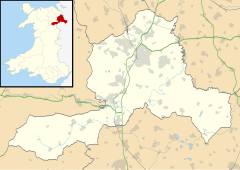Halghton (Welsh: Halchdyn[1]) is a dispersed settlement and former civil parish in the east of Wrexham County Borough, Wales. It is part of the community of Hanmer.
Halghton
| |
|---|---|
 Halghton Hall, depicted in 1794 | |
Location within Wrexham | |
| Community | |
| Principal area | |
| Preserved county | |
| Country | Wales |
| Sovereign state | United Kingdom |
| Post town | WHITCHURCH |
| Postcode district | SY13 |
| Police | North Wales |
| Fire | North Wales |
| Ambulance | Welsh |
| UK Parliament | |
| Senedd Cymru – Welsh Parliament | |
History
editHalghton is probably identifiable with the vill of "Hulhtune" noted in a 1043 charter of Leofric, Earl of Mercia, in which he bestowed a number of vills around Hanmer on his newly created monastery at Coventry.[2]
The placename was again recorded in 1295 as "Halcton", and as "Halghton" as early as 1334.[3] The name is of Old English origin, and means "farm (tun) in a corner of land (healh)".[4] From medieval times up until the 19th century Halghton was a township of the old parish of Hanmer, in the area of Flintshire known as the Maelor Saesneg.[5] The settlement never gained a church or point of focus, remaining dispersed across several kilometres.[4] Despite this it shows a long settlement history, including four moated sites, the site of a fulling mill recorded in the 15th century, and tracts of medieval ridge and furrow.[4] Under the 1866 Poor Law Amendment Act, the township of Halghton became a civil parish, while subsequent to an 1894 Act the civil parish became part of the Overton Rural District. When the latter along with Flintshire was abolished in 1974 Halghton became a ward of the community of Hanmer.
Notable buildings
editThe Grade I listed Halghton Hall is a small brick-built gentry house of 1662, with evidence of an earlier medieval core.[6][7]
Halghton Mill is a former corn mill, built in around 1802 and supplied with water through a leat from the Emral Brook.[8] Nearby are an early 18th century house and a former smithy, also of historic interest.
Notable residents
edit- John Hanmer, a patron of the poet Guto'r Glyn and one of the main Lancastrian supporters in North Wales during the Wars of the Roses: his house at Halghton was said to have been burned in 1463 by the Yorkist Duke of Norfolk and Lord Powis.
- Roger Brereton, Member of parliament for Flint Boroughs between 1604 and 1611.[9]
- Sir Thomas Hanmer, 2nd Baronet, who lived for a time at Halghton in his mother's dower house
References
edit- ^ "Standardised Welsh Place names". www.welshlanguagecommissioner.wales. Retrieved 29 March 2023.
- ^ St Chad Church and Well, Parish of Hanmer and Tallrn Green
- ^ Davies, E. (1959) Flintshire Place-names, UWP, p.83
- ^ a b c Halghton, Wrexham Sites and Monuments Record, accessed 15-05-18
- ^ History of Halghton, in Wrexham and Flintshire, Vision of Britain, accessed 15-05-18
- ^ "Halghton Hall (35862)", Coflein, RCAHMW accessed 15-04-18
- ^ Halghton Hall, British Listed Buildings
- ^ "Halghton Mill (24910)", Coflein, RCAHMW accessed 15-05-18
- ^ Flint Boroughs, History of Parliament Online
